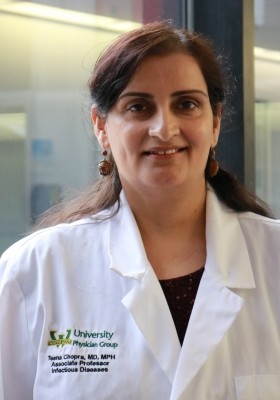“Plastic face shields add little protection to face masks, study finds” from Wayne State University School of Medicine
March 12, 2021
Studies conducted by Wayne State University School of Medicine physician-researchers indicate that the use of plastic face shields with surgical masks provides the best protection against COVID-19 infection, but combining the two made little difference over the use of masks alone.
The use of surgical masks alone provide good protection, surpassing that offered by face shields alone, is reported in the study, “A laboratory model demonstrating the protective effects of surgical masks, face shields, and a combination of both in a speaking simulation,” published in the American Journal of Infection Control.
“Surprisingly, when assessing the combined protection of surgical mask and face shield, the level of protection was not enhanced in comparison to using surgical masks alone,” said Teena Chopra, M.D., M.P.H., professor of Internal Medicine, Infectious Diseases, for the Wayne State University School of Medicine, and lead author of the study. “This result reinforces the fact that a surgical mask serves as an effective intervention, providing protection from aerosol droplets that spread COVID-19.”
To test the effectiveness of masks combined with face shields, Dr. Chopra and Hossein Salimnia, Ph.D., professor of Pathology, created an aerosol-generating device consisting of a nebulizer, oxygen tank and fan to simulate an infected human speaking to an uninfected human from a distance of 0.15 meters and 1.82 meters. They measured the number of bacterial colonies on agar plates, testing the effectiveness of masks, face shields, and the two combined.
When a face shield was used alone, the researchers found significant numbers of bacterial colonies developed on the agar plates. When only a mask was used, the plates developed minimal bacterial colonies. They found no significant improvement when face shields were used in combination with surgical masks.
As with many other respiratory infectious diseases, evidence suggests that SARS CoV-2, the virus that causes the infection, is transmitted when infected people expel virus-containing droplets by sneezing or coughing. Studies have also shown that breathing and talking can also expel droplets that contain the virus. Small respiratory particles from a patient cough can remain airborne and spread widely through a room, leaving others vulnerable to infection through inhalation.
“This simulation indicates that surgical masks worn by all are more likely to provide significant protection to uninfected participants in indoor conversations,” Dr. Chopra said. “The role of the face shields in preventing transmission is not supported, and if transmission via the eyes is felt to be a significant factor, such as with health care workers and dentists and dental technicians, goggles might provide better protection than a face shield.”
Read “Plastic face shields add little protection to face masks, study finds” from Wayne State University School of Medicine.
Learn more about Teena Chopra, M.D., M.P.H.
